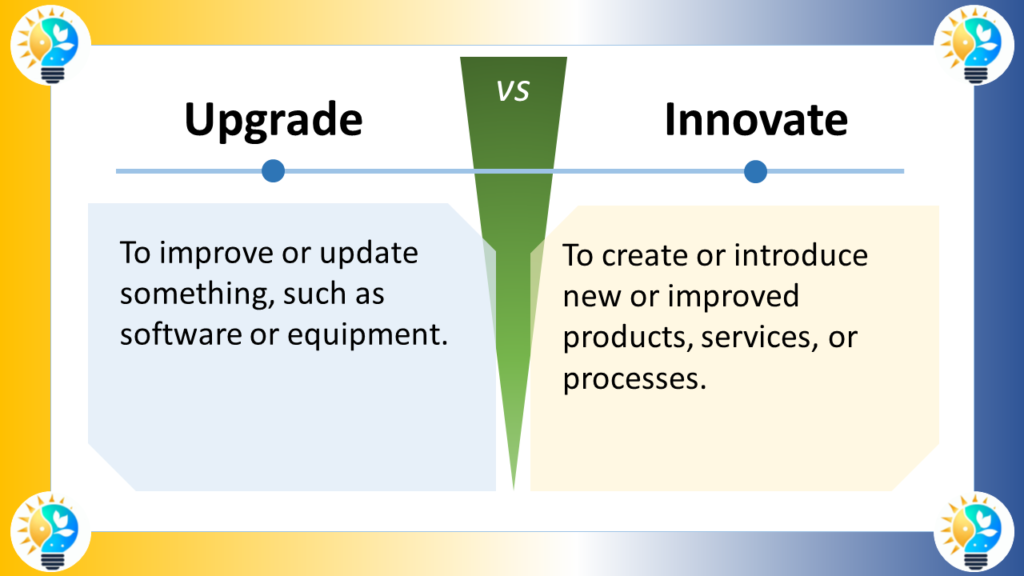Innovate and upgrade are two terms that relate to improving processes, products, or technologies, but they differ significantly in scope and impact.
Innovation refers to the introduction of something new or significantly improved, often changing the fundamental way things are done.
Upgrade, on the other hand, refers to enhancements made to an existing product or system, improving performance but generally not altering the basic nature of the object.

Definition
Innovate
Innovation involves implementing new ideas, creating dynamic products, or improving existing services in ways that significantly alter the approach or usage.
Characteristics of Innovation:
- Novelty: Introduces breakthrough methods or products.
- Significance: Often brings fundamental changes to the way things are done.
- Impact: Can lead to new markets or disrupt existing ones.
Upgrade
Upgrade refers to enhancing or augmenting an existing product, service, or system to improve its performance or efficiency without a fundamental change.
Characteristics of Upgrade:
- Incremental Improvement: Enhances features or performance of an existing system.
- Compatibility: Maintains the basic functionality and structure.
- Specificity: Focuses on specific components rather than an overall change.
More Synonyms on innovation, innovate and innovative:
- Adapt
- Advance
- Change
- Create
- Cultivate
- Devise
- Develop
- Discover
- Disrupt
- Evolve
- Experiment
- Fashion
- Generate
- Imagine
- Initiate
- Introduce
- Invent
- Modernize
- Originate
- Pioneer
- Progress
- Prototype
- Radicalize
- Reform
- Reinvent
- Renew
- Revolutionize
- Restructure
- Set Trends
- Transform
- Upgrade

Innovation is considered as a driving force in progress.
It includes the introduction of novel ideas, methods, or products that bring positive change and advancement.
For more information about innovations, check our glossary
Relationship and Relevance
While both innovation and upgrades are aimed at making improvements, innovation seeks to break new ground or introduce significant changes that can redefine a market or technology. Upgrades, however, refine and enhance existing functionalities to boost performance or user experience without altering the core essence of the product or service.
Based on the search results provided, the key differences between innovate and upgrade are:
Innovate refers to the process of creating something new or significantly improving upon an existing product, service or process. Innovation involves developing novel solutions, technologies or business models to meet market needs in a better way. [2][3]
Upgrade, on the other hand, refers to improving or enhancing an existing system or product by adding new features, capabilities or components. Upgrading is about iteratively improving and updating something that already exists, rather than creating something entirely new. [1][2]
Some key points:
- Upgrading is about making incremental improvements to existing systems, while innovating is about developing fundamentally new or transformed solutions. [1][2]
- Upgrading leverages existing infrastructure and expertise, while innovating requires more investment and risk in developing new capabilities from scratch. [2]
- Upgrading delivers near-term improvements, while innovating drives more transformational change over the long-term. [2]
- Upgrading is often a more cost-effective and less disruptive approach compared to full-scale innovation and new development. [1][2]
- However, over time, upgrading legacy systems becomes increasingly challenging and expensive, making innovation necessary to avoid technical debt and performance limitations. [2]
In summary, the main difference is that upgrading improves upon an existing product or system, while innovating creates something entirely new. Upgrading is an incremental, iterative process, while innovation is a more radical, transformative process. Both have their place, and organizations often pursue a hybrid strategy of both upgrading and innovating. [1][2]
Context for Using Each Term
- Innovate: Often used in contexts where radical or significant changes are being introduced, such as in technology development, business models, or creative industries.
- Upgrade: Commonly used in technical contexts, such as software updates, hardware improvements, or service enhancements in existing frameworks.
Example of Utilization
Innovate
A company develops a new electric vehicle with a solar-powered engine that significantly reduces dependency on traditional charging methods, introducing a novel solution to the market.
Upgrade
A software company releases an update for its photo editing software, enhancing the tool’s capabilities with faster processing speeds and better integration with other applications.
FAQ
Q: Can an upgrade lead to innovation?
A: While upgrades typically enhance existing features, a series of upgrades can cumulatively lead to innovative changes over time as improvements build on each other.
Q: Is innovation always technology-related?
A: No, innovation can occur in any field, including education, healthcare, business practices, and more, wherever novel ideas can be implemented to create significant changes.
Q: Are upgrades necessary for innovation?
A: Upgrades themselves are not necessary for innovation, but maintaining and improving existing systems can support the infrastructure necessary for innovative developments.
Understanding the differences between innovate and upgrade clarifies the scope and impact of changes made within any industry, helping stakeholders make informed decisions about the strategies they adopt.
[1] Richard Edwards – Update vs. Innovate: Knowing When is Best for Your Company
[2] Forbes – Innovate vs. Upgrade: New Technologies and Legacy Systems
[3] Innovations4 – Difference Between Improvement and Innovation
[4] UK CPI – The Difference Between Invention and Innovation

